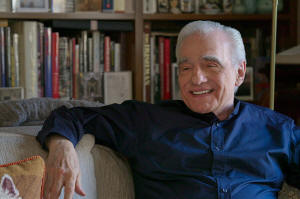In 'Mr. Scorsese,' fitting a filmmaking titan into the frame
[October 16, 2025]
By JAKE COYLE
NEW YORK (AP) — The first time the filmmaker Rebecca Miller met Martin
Scorsese was on the set of 2002's “Gangs of New York.” Miller’s husband,
Daniel Day-Lewis, was starring in it. There, Miller found an anxious
Scorsese on the precipice of the film’s enormous fight scene, shot on a
sprawling set.
“He seemed like a young man, hoping that he had chosen the right way to
shoot a massive scene,” Miller recalls. “I was stunned by how youthful
and alive he was.”
That remains much the same throughout Miller’s expansive and stirring
documentary portrait of the endlessly energetic and singularly essential
filmmaker. In “Mr. Scorsese,” which premieres Friday on Apple TV, Miller
captures the life and career of Scorsese, whose films have made one of
the greatest sustained arguments for the power of cinema.
“We talk about 32 films, which is a lot of films. But there are yet more
films,” Miller says, referencing Scorsese’s projects to come. “It’s a
life that overspills its own bounds. You think you’ve got it, and then
it’s more and more and more.”
Scorsese’s life has long had a mythic arc: The asthmatic kid from Little
Italy who grew up watching old movies on television and went on to make
some of the defining New York films. That’s a part of “Mr. Scorsese,”
too, but Miller’s film, culled from 20 hours of interviews with Scorsese
over five years, is a more intimate, reflective and often funny
conversation about the compulsions that drove him and the abiding
questions — of morality, faith and filmmaking — that have guided him.

“Who are we? What are we, I should say?” Scorsese says in the opening
moments of the series. “Are we intrinsically good or evil?”
“This is the struggle,” he adds. “I struggle with it all the time.”
Miller began interviewing Scorsese during the pandemic. He was then
beginning to make “Killers of the Flower Moon.” Their first meetings
were outside. Miller first pitched the idea to Scorsese as a
multifaceted portrait. Then, she imagined a two-hour documentary. Later,
by necessity, it turned into a five-hour series. It still feels too
short.
“I explained I wanted to take a cubist approach, with different shafts
of light on him from all different perspectives — collaborators,
family,” Miller says. “Within a very short amount of time, he sort of
began talking as if we were doing it. I was a bit confused, thinking,
‘Is this a job interview or a planning situation?’”
Scorsese’s own documentaries have often been some of the most insightful
windows into him. In one of his earliest films, “Italianamerican”
(1974), he interviewed his parents. His surveys of cinema, including
1995’s “A Personal Journey With Martin Scorsese Through American Movies”
and 1999’s “My Voyage to Italy,” have been especially revealing of the
inspirations that formed him. Scorsese has never penned a memoir, but
these movies come close.
While the bulk of “Mr. Scorsese” are the director’s own film-to-film
recollections, a wealth of other personalities color in the portrait.
That includes collaborators like editor Thelma Schoonmaker, Paul
Schrader, Robert De Niro, Leonardo DiCaprio and Day-Lewis. It also
includes Scorsese’s children, his ex-wives and his old Little Italy
pals. One, Salvatore “Sally Gaga” Uricola for the first time is revealed
as the model for De Niro’s troublemaking, mailbox-blowing-up Johnny Boy
in “Mean Streets.”
[to top of second column]
|

This image released by Apple TV+ shows filmmaker Martin Scorsese in
a scene from the documentary series "Mr. Scorsese." (Apple TV+ via
AP)
 “Cinema consumed him at such an
early age and it never left him,” DiCaprio says in the film. “There
will never be anyone like him again,” says Steven Spielberg.
It can be easy to think of Scorsese, perhaps the most revered living
filmmaker, as an inevitability, that of course he gets to make the
films he wants. But “Mr. Scorsese” is a reminder how often that
wasn’t the case and how frequently Scorsese found himself on the
outside of Hollywood, whether due to box-office disappointment, a
clash of style or the perceived danger in controversial subjects
(“Taxi Driver,” “The Last Temptation of Christ”) he was drawn to.
“He was fighting for every single film,” Miller says. “Cutting this
whole thing was like riding a bucking bronco. You’re up and you’re
down, you’re dead, then alive.”
Film executives today, an especially risk-averse lot, could learn
some lessons from “Mr. Scorsese” in what a difference they can make
for a personal filmmaker. As discussed in the film, in the late
’70s, producer Irwin Winkler refused to do “Rocky II” with United
Artists unless they also made “Raging Bull.”
For Miller, whose films include “The Ballad of Jack and Rose” and
“Maggie’s Plan,” being around Scorsese was an education. She found
his films began to infect “Mr. Scorsese.” The cutting of the
documentary took on the style of his film’s editing. “In proximity
to these film,” she says, “you start to breathe the air.”
Nearness to Scorsese also inevitably means movie recommendations.
Lots of them. One that stood out for Miller was “The Insect Woman,”
Japanese filmmaker Shōhei Imamura’s 1963 drama about three
generations of women.
“He’s still doing it,” Miller says. “He’s still sending me movies.”

“Mr. Scorsese” recently debuted at the New York Film Festival, where
Miller's son, Ronan Day-Lewis made his directorial debut with
“Anemone,” a film that marked her husband's return from retirement.
At the “Mr. Scorsese” premiere, a packed audience at Lincoln
Center's Alice Tully Hall came to enthusiastically revel in, and pay
tribute to its subject.
“You hear all those people laughing with him or suddenly bursting
into applause when they see Thelma Schoonmaker or at the end of the
‘Last Waltz’ sequence,” Miller says. “There was a sense of such
palpable enthusiasm and love. My husband said something I thought
was very beautiful: It reminded everyone of how much they love him.”
All contents © copyright 2025 Associated Press. All rights reserved |